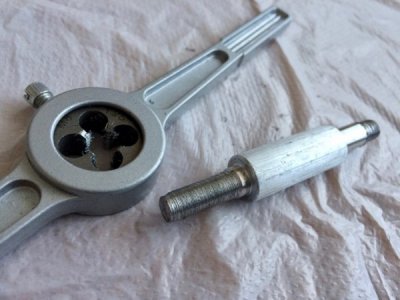- Joined
- Feb 13, 2017
- Messages
- 2,138
I am not really the best person (not even pretty good) to get involved in this conversation.I have been a maintenance man in steel mills for years. And part time boss where having to think on my feet was a primary function. With several hundred tons of hot and molten steel in play, there isn't time to think about the problem. Just cobble it together it and keep the mill running. Certainly no spills...... messy!
A few points on your threading:
For external threads, tapering the shaft such as mentioned above is applicable for all metals and all grades of dies. I often turn a starter shaft to the smaller diameter of the thread to give the die a place to start true. This in addition to the taper. It helps on the lathe. Mandatory if the threading is going to take place later in a vise or whatever.
For internal threads, starting with metric is easier to describe. Imperial works the same, just harder to figure.
Start with a 10mm tap. The usual thread is 1.5mm pitch. Take the 10mm bolt minus the 1.5mm pitch and there is the size to be drilled. 8.5mm. This may not deliver the optimum 86% thread tooth engagement, but it is close enough to hold an automotive engine assembly together. And get you up and running without worrying about a chart or wires.The diameter minus the thread pitch.....
For imperial threads, think 3/8-16. It would be 3/8 (0.375) minus 1/16 (0.0625) for drill size. 5/16" as I recall.... And 5/16 is a good starter size for a 10mm tap as well. A letter drill a few thou larger would be better, of course.
I happen to be able to juggle numbers in my head pretty good so it's easy for me to juggle imperial and metric. Comes from model building. Some folks not so easy..
Hope that helps in your endeavers,
A few points on your threading:
For external threads, tapering the shaft such as mentioned above is applicable for all metals and all grades of dies. I often turn a starter shaft to the smaller diameter of the thread to give the die a place to start true. This in addition to the taper. It helps on the lathe. Mandatory if the threading is going to take place later in a vise or whatever.
For internal threads, starting with metric is easier to describe. Imperial works the same, just harder to figure.
Start with a 10mm tap. The usual thread is 1.5mm pitch. Take the 10mm bolt minus the 1.5mm pitch and there is the size to be drilled. 8.5mm. This may not deliver the optimum 86% thread tooth engagement, but it is close enough to hold an automotive engine assembly together. And get you up and running without worrying about a chart or wires.The diameter minus the thread pitch.....
For imperial threads, think 3/8-16. It would be 3/8 (0.375) minus 1/16 (0.0625) for drill size. 5/16" as I recall.... And 5/16 is a good starter size for a 10mm tap as well. A letter drill a few thou larger would be better, of course.
I happen to be able to juggle numbers in my head pretty good so it's easy for me to juggle imperial and metric. Comes from model building. Some folks not so easy..
Hope that helps in your endeavers,
Bill Hudson


